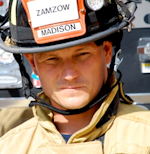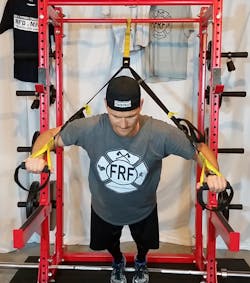With a lot of focus on firefighter health and wellness, it’s no wonder that you might be hearing a lot of talk about popular fitness trends and workouts. Discussing these trends in the firehouse can sometimes be as complicated as talking about politics or even fire attack. Some of the more popular fitness trends aren’t what I would call “valid” for the fire service, while others can absolutely help improve your performance. So, put down the Shake Weight, because here are five fitness trends coming to (or should be coming to) a firehouse near you.
1. Functional training
“Functional training” has become a popular buzzword in the fitness industry and is now making its way to the fire service. The revolution began, as it often does, with physical therapists, and functional training was slowly adopted by strength coaches and personal trainers. So what is it? The Mayo Clinic defines functional training as incorporating movements into workouts to prepare the body for daily tasks by simulating common movements done at home, at work or in sports.
As firefighters, we perform a wide range of movement activities, such as climbing, lifting, dragging, crawling, swinging, pushing, twisting, carrying and bending. In order for a workout to be functional to the firefighter, it needs to train these specific movements, the muscles involved in the movement, the energy systems required for the movement, and the brain that controls the movement. In short, functional fitness for the firefighter goes far beyond improving an impressive one repetition max on the bench press. It includes exercises that mimic fireground and rescue ground movements and, invariably, improve performance.
Further, most would agree that there is nothing “functional” about sustaining an injury due to improper training, so it’s important to do functional fitness the right way. While there are a lot of individuals and organizations claiming to have programs focused on firefighter fitness, many of these programs are very basic and do not meet the complete demands of the firefighter. Make sure that any program you follow has legitimacy and is written by individuals who are certified and experienced in fitness programming and who also understand the functional demands of the firefighter. You wouldn’t get information about fire attack from someone outside of the fire service. The same must apply with your fitness.
2. Interval training/HIIT
Interval training has gained a lot of popularity in the sports conditioning community and has been a growing trend in group fitness. High-intensity interval training (HIIT) is characterized by intense bursts of exercise followed by short rest periods. Some experts believe that HIIT is a more efficient form of exercise that can minimize time spent at the gym. This type of training is very applicable to what firefighters do on the fireground. Lots of recent research studies have demonstrated the effectiveness of interval training. It boost metabolism, improves aerobic and anaerobic capacity, burns more calories than longer-duration/lower-intensity workouts, and can even improve cholesterol profiles. It is also very beneficial for firefighters to help prepare their bodies to go from “0 to 100” at a moment’s notice.
The basic skeleton of an interval workout is simply a “work interval” followed by a “rest interval” repeated a set number of times. During the work interval, the intensity must be very high, one in which you would not be able to carry on a conversation. The rest interval should include very light movement, like walking or jogging. The number of intervals and overall duration of the workout depends on your level of fitness and goal.
3. Foam rolling
Foam rolling is a common mobility technique that athletes have been utilizing for years. Track stars, football players and even ballerinas have used the foam roller as the go-to tool for working out knots and addressing muscle pain. This fitness tool should not be limited to the arenas of sport and dance, and will hopefully make its way into every firehouse.
A foam roller is a compressed foam cylinder that comes in various lengths and consistencies. By slowly rolling your body weight along the foam roller, you massage the adhesions (knots) that may occur in your muscles (especially those of the legs and back) and thus cause the muscles and nerves to relax and loosen. This allows blood to flow more freely through the muscles and allows them to heal and repair more efficiently.
The exercise physiology geeks and peer fitness trainers refer to this concept as “self-myofascial release.” You will probably love and hate the foam roller. I encourage you to try it more than a week before formulating an opinion on its effectiveness. Just like a massage, there will be some discomfort when you hit the right spot. Over time, the foam roller will get easier. Your muscles will be healthier and have less adhesions (knots), thereby improving flexibility, mobility and, ultimately, your performance.
4. Yoga
You may never thought the word yoga would be said in the in the same sentence with the word firefighter, but this growing fitness trend can no longer be ignored in the fire service. The benefits of yoga are undeniable—increased muscle strength, improved energy, weight loss, improved circularity health, reduced stress, improved athletic performance and protection from injury.
Yoga is scalable; it can be as mellow or as arduous as you make it, just like any physical practice. The beauty of yoga is that it goes beyond just the physical. For firefighters, yoga can be a really great way to relieve stress and center the body and mind. This is especially important considering the high stress of the job. Yoga, if you allow it to be so, could be one of the best ways to also combat post-traumatic stress disorder.
Now I am not saying to carry a yoga mat with you to the firehouse on every shift. I am, however, saying that this can be a great way to relieve stress, increase strength, improve muscular endurance and even reduce back pain. Yoga has many styles and paces. You can learn through yoga books and videos, and beginners usually find it helpful to learn with an instructor. Classes also offer camaraderie and friendship, which are also important to overall well-being. Another option is to bring instructors into the firehouse to teach a class on-shift. My suggestion is to give it a try; you may find that it relieves stress and helps you move better on the fireground.
5. Crew workouts
A growing trend around the fire service is to use functional fitness movements and incorporate them into crew interval workouts. This practice can be seen at major conferences, like Firehouse Expo and Firehouse World, and is helping to improve the fitness culture of fire departments. Working out with your crew can not only lead to better fitness results, but also add camaraderie and help you work better as a team.
Here is an example of a workout you could try with your crew. Start with a 5-minute active warm-up that increases mobility and gets a sweat going. Next, set up five or six functional exercises, like sledges on a tire, drags, crawls, stairs or a core exercise. These movements can be performed for reps (10 to 15) or for a specific amount of time (30 seconds) with minimal rest between them (30 seconds). Try to repeat the circuits three or four times for a great workout in under 30 minutes. Be creative, you could add different exercises, perform the workout in gear or even on air.
Look ahead
The fire service is usually a little apprehensive to grasp newer trends and is a little behind the times when it comes to health and fitness. Many firehouses probably still have the big multi-station gym, broken down fitness equipment or no equipment at all. The good news is that the trends identified here don’t require a lot of equipment nor money to implement. So, think more functionally, perform some crew interval workouts, grab a foam roller and do some yoga. Your body and career will thank you.
P.S., See you in Nashville for a great crew workout.

Aaron Zamzow
Aaron Zamzow is a firefighter/training officer for Madison, WI, Fire Department. He holds a bachelor’s degree in health/wellness and has 20 years of experience as a fitness trainer. He created Fire Rescue Fitness and authors programs that are aimed at getting fire rescue athletes fit for duty.






